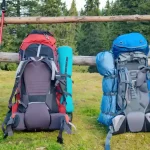

Embrace Outdoor Bliss with Lightweight, Durable, and Versatile Camping Hammocks
by
Emily Wychwood
Embrace the serenity of nature with the perfect camping hammock. This guide covers selecting from single, double, ultralight, and camping-specific hammocks, each suited for different camping needs and preferences. It emphasizes the importance of considering weight capacity, material durability, ease of setup, comfort features, packability, and price. Additionally, the guide offers insights on hammock setup, essential accessories like suspension systems, tree protectors, rainflies, bug netting, and quilts for a comfortable experience.
Imagine the sheer bliss of gently swaying in a hammock, surrounded by nature’s tranquility. In this blog post, we delve into the world of hammocks, uncovering their versatility, comfort, and how they elevate the camping experience. Join me on this journey as we discover the allure of hammock camping and learn how to choose the perfect hammock, set it up with ease, and embrace the hammock lifestyle.
Choosing the Perfect Hammock
Single Hammocks:
Ideal for solo campers or those seeking a cozy and compact setup, single hammocks provide a comfortable sleeping area for one person. They are lightweight, easy to set up, and perfect for minimalist backpacking trips. Consider hammocks like the Grand Trunk Ultralight Hammock or the Hummingbird Ultralight Single Hammock. These hammocks are crafted from durable materials, offer ample space for rest, and are designed to be ultralight for backpackers who prioritize weight savings.

Double Hammocks:
If you prefer more space or enjoy sharing your hammock with a partner or furry friend, double hammocks are the way to go. These hammocks offer a wider sleeping area, providing room for two people or luxurious solo lounging. Look for options such as the ENO DoubleNest Hammock or the Kammok Roo Double Hammock. These hammocks often have higher weight capacities and sturdy construction, ensuring a comfortable experience for couples or individuals seeking extra room to relax.
Camping-Specific Hammocks:
For campers who prioritize durability, weather resistance, and additional features, camping-specific hammocks are worth considering. These hammocks often come with built-in bug nets, rainfly attachments, and storage pockets for convenience. Examples include the Hennessy Hammock Expedition Series or the Clark NX-270 Four-Season Camping Hammock. These hammocks are designed to withstand various weather conditions, provide enhanced protection, and offer a complete sheltered sleeping system.

Ultralight Hammocks:
For backpackers and hikers aiming to minimize weight without compromising comfort, ultralight hammocks are the way to go. These hammocks are constructed from lightweight materials such as nylon or Dyneema, resulting in a significantly reduced pack weight. Look for options like the Hummingbird Ultralight Single Hammock or the Sea to Summit Ultralight Hammock. These hammocks prioritize weight savings and portability while still offering a comfortable and reliable sleeping area.
When choosing the right hammock for your camping adventures, consider the following factors:
- Weight Capacity: Ensure the hammock can support your weight and any additional gear you may bring.
- Material Durability: Look for hammocks made from sturdy and tear-resistant materials to withstand outdoor conditions.
- Ease of Setup: Consider hammocks with user-friendly suspension systems, intuitive attachment points, and adjustable straps for effortless setup.
- Comfort Features: Check for features like built-in spreader bars, ergonomic designs, or additional padding for enhanced comfort.
- Packability: If you plan to carry your hammock on backpacking trips, opt for hammocks that pack down into a compact size and are lightweight.
- Price: Consider your budget and balance it with the desired features and quality of the hammock.
By considering these factors and exploring the wide variety of hammocks available, you can find the perfect hammock that aligns with your camping needs, comfort preferences, and budget.
Hammock Setup and Accessories
Setting up a hammock may seem daunting at first, but with the right guidance and accessories, it becomes a straightforward process. In this section, we’ll explore the essentials of hammock setup and highlight various accessories that can enhance your camping experience.
Suspension Systems:
To hang your hammock, you’ll need a reliable suspension system. There are different types to choose from, including webbing straps, suspension ropes, or adjustable straps. Webbing straps, such as the ENO Atlas Suspension System or the Grand Trunk TreeSlings, provide a wide surface area for attaching your hammock to trees while minimizing impact. Suspension ropes, like the Kammok Python Straps or the Hummingbird Tree Straps, offer a lightweight and adjustable option for quick and easy setup. Adjustable straps, such as the DutchWare Gear Beetle Buckle Suspension System, provide flexibility in length and tension for precise hanging.

Tree Protectors:
Protecting the trees you hang your hammock from is essential for minimizing damage. Tree protectors, also known as tree huggers, are wide straps that wrap around the tree trunk, distributing the weight of your hammock more evenly. Look for options like the ENO Tree Protector Straps or the Bear Butt Tree Hugger Straps. These straps not only safeguard the trees but also prevent bark damage and leave minimal impact on the environment.
Rainfly:
When camping in inclement weather, a rainfly is an invaluable accessory to keep you dry and sheltered. Rainflies are waterproof covers that provide protection against rain, wind, and other elements. Look for rainfly options compatible with your hammock, such as the ENO DryFly Rain Tarp or the Snugpak Hammock Cocoon. These rainflies are designed to be lightweight, easy to set up, and offer ample coverage to keep you and your hammock dry during unexpected showers.

Bug Netting:
To ward off pesky insects and ensure a peaceful night’s sleep, consider using a bug net. Bug netting is a mesh enclosure that surrounds your hammock, keeping mosquitoes, flies, and other bugs at bay. Examples include the Guardian Bug Net by ENO or the Skeeter Beeter Pro Bug Net by Grand Trunk. These bug nets are designed to provide maximum airflow while effectively preventing insects from disturbing your rest.
Underquilts and Top Quilts:
For insulation in cooler temperatures, underquilts and top quilts are excellent additions to your hammock setup. Underquilts hang beneath your hammock, providing insulation from below, while top quilts function as cozy blankets to keep you warm from above. Look for options like the Hammock Gear Incubator Underquilt or the Enlightened Equipment Revelation Quilt. These quilts are available in various temperature ratings and offer lightweight, compressible insulation for comfortable sleeping in colder conditions.
By considering these accessories and incorporating them into your hammock setup, you can enhance your camping experience, stay protected from the elements, and ensure a comfortable night’s sleep. Remember to choose accessories that are compatible with your specific hammock and align with your camping needs and environmental considerations.
FAQS
Camping hammocks can be incredibly comfortable to sleep in when properly set up. They provide a unique floating sensation and the ability to adjust your sleeping position to your liking. Many hammocks also offer ergonomic designs and additional features such as built-in padding or spreader bars for added comfort.
Most camping hammocks have weight capacities ranging from 200 to 500 pounds, depending on the model and brand. It’s important to check the weight capacity of the specific hammock you are considering to ensure it can support your weight and any additional gear you may have.
Some camping hammocks come with built-in bug netting, which provides protection against mosquitoes, flies, and other insects. If your chosen hammock doesn’t include a bug net, you can purchase a separate one that is compatible with your hammock to keep bugs at bay during your outdoor adventures.
Camping hammocks are designed to be used in various weather conditions. However, it’s important to note that without proper insulation or protection, hammocks alone may not provide adequate warmth during colder temperatures. You can use accessories like underquilts, top quilts, or sleeping pads to provide insulation underneath or on top of your hammock, respectively. Additionally, using a rainfly or tarp can offer protection from rain, wind, and other elements.
Yes, camping hammocks are a popular choice among backpackers due to their lightweight and compact nature. Many hammocks are designed to be ultralight and packable, making them ideal for backpacking adventures where weight and space are crucial considerations.
To care for your camping hammock, it’s important to follow the manufacturer’s care instructions. In general, avoid exposing the hammock to sharp objects or abrasive surfaces that could damage the fabric. Clean the hammock as needed, following the recommended cleaning method (often a gentle hand wash or machine wash on a delicate cycle). Proper storage in a dry and well-ventilated area is also essential to prevent mold or mildew growth.
Conclusion
In conclusion, hammocks are a gateway to serenity and outdoor bliss. They provide a unique and immersive way to experience the great outdoors, encouraging us to disconnect from the hectic pace of life and embrace nature’s soothing embrace. So, whether you’re an avid camper or seeking a tranquil space to unwind, consider incorporating hammocks into your outdoor adventures and embrace the serenity they offer.
If you think that hammocks aren’t for you, why not read How to Choose the Right Sleeping Pad for Hiking
Author

Emily Wychwood
Emily is an avid camper and outdoors enthusiast, with a passion for exploring new places and trying out new gear. She grew up camping with her family and has continued the tradition with her own children, who love nothing more than roasting marshmallows around the campfire.
Recent Posts


